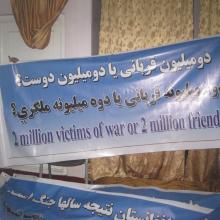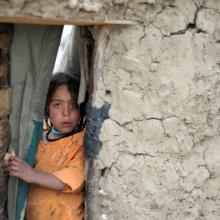Afghanistan
A fundamental principle [of ancient Greek tragedy], often overlooked, is that the double and the monster are one and the same being.
- René Girard, Violence and the Sacred (p. 160)
The debate about the use of drone strikes in the so-called “War on Terror ” has shed light on an inevitable calculus of war: how many civilian casualties can be tolerated in pursuit of our goals? President Barack Obama, in his speech on May 23 at National Defense University, referred to the drone strikes in Pakistan, Yemen, and Somalia, admitting, “It is a hard fact that U.S. strikes have resulted in civilian casualties, a risk that exists in all war.” But of course, our wars and our use of drones were conceived as a legitimate response to the civilian deaths on 9/11 and a defensive maneuver to prevent future attacks.
Obama Defends Drone Attacks
In his speech, Obama further justified the use of drones by stating it reduces the number of civilian casualties compared to boots-on-the-ground wars. Though the numbers are hard to determine, it has been reported by the Canadian Broadcasting Corporation that civilian casualties caused by our invasion of Iraq number somewhere between 55,000 and 60,000. In Afghanistan, from the time reporting began in 2007, the Guardian reports that the total number of civilians who have lost their lives in the armed conflict to be 14,728. For drone strikes, the highest estimates put total civilian deaths at around 950, indisputably a better number.
The Illogical Logic of Violence
Reducing the number of deaths caused by our use of violence is a worthy goal, and Obama does seem genuinely engaged in drawing the number down. So for the sake of argument, I will take him at his word. But (you knew there was a but coming!), he is trapped, as so many of us are, within the logic of violence.
When she was 24 years old, in 1979, Fahima Vorgetts left Afghanistan. By reputation, she had been outspoken, even rebellious, in her opposition to injustice and oppression; and family and friends, concerned for her safety, had urged her to go abroad. Twenty-three years later, returning for the first time to her homeland, she barely recognized war-torn streets in urban areas where she had once lived. She saw and felt the anguish of villagers who couldn’t feed or shelter their families, and no less able to accept such unjust suffering than she’d been half her life before, Fahima decided to make it her task to help alleviate the abysmal conditions faced by ordinary Afghans living at or below the poverty line — by helping to build independent women’s enterprises wherever she could.
Something happened last week and I still can’t shake the funk of it off me. It happened in Boston and Texas; I saw it in Chicago as well, and the week before in Afghanistan. Last Sunday I tried to be a dutiful pastor and make sense of it from the pulpit, but ended up saying that I couldn’t make any sense of it. It wasn’t in what happened but the response. Not that they were making too much out of it — no, these tragedies were tragedies — but that maybe we weren’t making enough of it.
When the smoke of the bombs rescinded, we did what national pride dictates — we put “Boston Strong” all over everything and took up pledges to run the Boston Marathon (the first 10-miler will cause significant reassessment of this showing of national pride) — but we also began a collective process of national mourning and deep reflection, of asking, “How could this have happened?” When we knew nothing of the perpetrators, we asked instead about terrorism and mental illness — root causes (?). We expanded our search, into new territory that resembled 9/11 in some ways, back when we knew nothing and all parties were guilty parties. Accountability was spread wide, including home. This was not a search for a scapegoat but a search for the soul of a nation.
IT'S BEEN SAID that one of the most radical things Jesus did was to eat with the wrong crowd. Undoubtedly, folks on the Left were frustrated with Jesus for making friends with Roman tax collectors. And folks on the Right were surely ticked at him for hanging out with Zealots. Dinner must have been awkward with both of them at the table; after all, Zealots killed tax collectors for fun on weekends.
But Jesus was a subversive friend, a scandalous bridge-builder, a holy trespasser. Just as we are known by the company we keep, so was Christ—accused of being a "glutton and a drunkard, a friend of tax collectors and sinners" (Luke 7:34). He was put on trial for being a rabble-rouser and a traitor. He got in trouble with the religious elite for crossing the line, overstepping purity laws and cultural norms, and disrupting the status quo. His love had no bounds and his friendships defied categories. He insisted on calling his followers friends: "I no longer call you servants, because a servant does not know his master's business. Instead, I have called you friends" (John 15:15).
Jesus made friends—with folks who adored him and folks who hated him. He sat with the woman at the well, washed the feet of his disciples, wept at the death of his buddy Lazarus, and loved his mom and dad. But his love went beyond borders. He redefined family, inviting his followers to be "born again" and discover an identity that runs deeper than biology. He challenged the chosen and included the excluded—in the family of God.
I wonder who Jesus would be hanging out with if he were around today?
IN EARLY AUGUST 2010, 10 aid workers were murdered, execution-style, in the province of Badakhshan, in northeastern Afghanistan. Among them were six Americans, two Afghans, a Briton, and a German, all part of a medical mission. It was the deadliest attack on aid workers the country had seen.
Dan Terry, 63, an American humanitarian who, with his family, had called Afghanistan home for more than 30 years, was among the dead.
What compels a person to risk his or her life in a foreign land so riddled with conflict? For Terry it was simple—he was called to a life of peacemaking and service.
A friend of Terry's since childhood, writer Jonathan Larson draws us into Terry's passionate character and the vision he shared with friends in Afghanistan: reconciliation and dialogue. "In the end, we're all knotted into the same carpet," Terry was fond of saying. From a swath of interviews with family, friends, and colleagues, both Western and Afghan, Larson has assembled "oral narratives," sharing with us the exhilarating life of a generous and gentle man, heroic but humble.
The best advice I received as a humanitarian aid worker in Afghanistan was from a leader cut from the same cloth as Terry: "Make no assumptions" and "listen first." We too often accept media caricatures of the other, labels that shut down discourse and clamp off possibility and hope. Challenging this, Terry insisted on the unwavering potential of each person he met. "Categorical 'enemies' have rescued me ... again and again," he once wrote to friends.
Sen. Rand Paul’s 13-hour filibuster last week against the administration’s drone policy brought a long-simmering debate to a full public boil. Although some have criticized him for “grandstanding,” the Kentucky Republican did all of us a favor. Issues and questions that had been raised primarily by progressive bloggers and peace groups are now in full public view and debate in the mainstream media.
The New York Times carried front page stories both days this weekend. On Saturday, it highlighted the growing opposition to drones from across the political spectrum, writing that Sen. Paul’s filibuster had hit a “bipartisan nerve,” and:
“… animated a surprisingly diverse swath of political interests that includes mainstream civil liberties groups, Republican and Democratic lawmakers, conservative research groups, liberal activists and right-wing conspiracy theorists.”
THIS JUST IN — horrific news from our friends in Kabul. Over the weekend two kids, age 7 and 8, were killed by NATO forces while herding cattle in the Uruzgan Province in Afghanistan.
The Afghan Peace Volunteers, with whom Shane visited a few weeks ago, took to the streets in nonviolent protest.
They were accompanied by a couple of cows, as a reminder of the innocence of these children who were killed alongside their livestock.
They carried signs that read: “We are those 2 children.” Here is a video they sent us:
Ross Douthat posits that President Obama’s nominations of former Sen. Chuck Hagel as Secretary of Defense and John Brennan as Director of the Central Intelligence Agency represent the synthesis of two strains in former President George Bush’s foreign policy. Hagel as one of those who turned against the war in Iraq, and Brennan as one of those who defended controversial counterterrorism policies.
“To the extent that it’s possible to define an “Obama Doctrine,” then, it’s basically the Hagel-Brennan two-step. Fewer boots on the ground, but lots of drones in the air. Assassination, yes; nation-building, no. An imperial presidency with a less-imperial global footprint.
“This is a popular combination in a country that’s tired of war but still remembers 9/11 vividly. Indeed, Obama’s foreign policy has been an immense political success: he’s co-opted foreign policy realists, neutralized antiwar Democrats and isolated Republican hawks.”
Counter-insurgency wars, such as those in Iraq and Afghanistan, frequently place soldiers in morally ambiguous situations. What they did or didn’t do in those situations can leave lasting moral effects. Following an epiphany at an antiwar rally, Rev. Rita Nakashima Brock:
“… has devoted the years since then to tending the spiritual wounds of warriors, seeking theological answers to the condition among veterans called “moral injury.” In her current position at Brite Divinity School in Fort Worth, she has begun the first program in the nation to develop a treatment that she terms 'soul repair.'
“Moral injury might best be defined as an affliction of the soul, as distinct from a specific mental health condition like post-traumatic stress disorder. It arises, to speak in a very broad way, from the way a combatant’s actions in war seem to violate and thus undermine the most deeply held moral beliefs.”
Her “Soul Repair Center” is now teaching congregational leaders how to address moral injury among veterans.
Kabul —Yesterday, four young Afghan Peace Volunteer members, Zainab, Umalbanin, Abdulhai, and Ali, guided Martha and me along narrow, primitive roads and crumbling stairs, ascending a mountain slope on the outskirts of Kabul. The icy, rutted roads twisted and turned. I asked if we could pause as my heart was hammering and I needed to catch my breath. Looking down, we saw a breathtaking view of Kabul. Above us, women in bright clothing were navigating the treacherous roads with heavy water containers on their heads or shoulders. I marveled at their strength and tenacity. “Yes, they make this trip every morning,” Umalbanin said, as she helped me regain my balance after I had slipped on the ice.
About 10 minutes later, we arrived at the home of Khoreb, a widow who helped us realize why so many widows and orphans live in the highest ranges of the mountain. Landlords rent one-room homes at the cheapest rates when they are at this isolating height; many of the homes are poorly constructed and have no pipes for running water. This means the occupants, most often women, must fetch water from the bottom of the hill each and every morning. A year ago, piped water began to reach some of the homes, but that only meant the landlords charged higher rent, so women had to move higher up the mountain for housing they can afford. It only made their daily water-carrying longer and more arduous.
Afghanistan is one of the most desperate, beat up places in the world. Forbes magazine has called it the most dangerous nation on earth. Over 30 years of war have left 2 million people dead, and much of the country in chaos. But even in the most troubled places on earth, there always seems to be a little group of people who refuse to accept the world as it is and insist on building the world they dream of, a little group of people who believe despite the evidence and watch the evidence change.
A few years ago, I began to hear about a little group of young people in Afghanistan doing exactly that. Many of them had seen their loved ones, friends and family killed. They were tired of blood. Tired of war. And so they began to organize, and educate, and train themselves for peace. They studied the heroes of nonviolence, Gandhi and King. A few of them even travelled to India to learn nonviolence and community from Gandhi’s ashram. Now they have their own ashram in Kabul, where dozens of them live together and work for peace.
And they have begun to build a movement: marching in the streets, planting trees, building parks as monuments of peace. They started wearing blue scarves as a symbolic reminder that there is one blue sky that connects us all, and now their little movement is catching the world’s attention. It is a movement of friends without borders.
The motto of their movement is this: “A little bit of love is stronger than all the weapons in the world.”
We call upon the United Nations to negotiate an immediate cease-fire to the war in Afghanistan, and to start talks aimed at ending the war and beginning the long road to healing and recovery.
That’s what the Afghan youth said on Tuesday afternoon in Kabul, along with Nobel Peace Prize winner Mairead Maguire of Ireland, as they launched their “Two Million Friends for Afghanistan” campaign and presented their petition to a senior United Nations official.
For me, it was the climax of a heart-breaking, astonishing eight days in one of the poorest, most violent, most war-torn, most corrupt, and most polluted places on the planet — and because of the amazing “Afghan Peace Volunteers,” the 25 Afghan youth who live and work together in a community of peace and nonviolence — one of the most hopeful.
Most drone attacks in Pakistan and Yemen are eventually reported. Not so in Afghanistan. Since they are part of an ongoing war, they don’t make the news. But Stuart Ackerman, writing in Wired, finds that the Air Force reported last week that there have been 447 drone strikes in Afghanistan this year.
“Never before in Afghanistan have there been so many drone strikes. For the past three years, the strikes have never topped 300 annually, even during the height of the surge. Never mind 2014, when U.S. troops are supposed to take a diminished role in the war and focus largely on counterterrorism. Afghanistan’s past year, heavy on insurgent-hunting robots, shows that the war’s future has already been on display.”
WHEN AMBASSADOR Chris Stevens was killed in Benghazi, Libya, in September, it was jarring for me to hear NPR refer to the last U.S. ambassador to be slain: my father, Adolph Dubs. He was kidnapped in 1979 in Kabul, Afghanistan, by Afghan extremists whose motives were never learned, and killed hours later in a botched armed response by the Soviet-allied Afghan government, even as U.S. diplomats pleaded for more time to negotiate.
My dad was 58, a career diplomat. After serving in the Navy during World War II, he had entered the foreign service, compelled by a deep desire to learn to use diplomacy to blunt the forces of fear and hate at the root of violent conflict. As a young man, he had considered the Lutheran ministry; he saw his work as a diplomat as a pragmatic way to build relationships, even with those whose histories and beliefs seemed alien to our own. People sensed this about him. Whether meeting with the Soviets at the height of the Cold War, with Serbian farmers in the former Yugoslavia, or, finally, with Afghans in the uncertain and perilous months before the Soviet invasion, he was universally respected for his integrity and commitment, and even loved for his genuine humanity and humor.
Among the many expressions of sympathy I received following his death, one photo is particularly meaningful. It's not the one depicting U.S. Secretary of State Cyrus Vance and other dignitaries receiving my father's casket at Andrews Air Force Base—rather, it's an image (above) taken in the courtyard of the embassy in Kabul. It shows the Afghan men who knew him, who had lived and worked around him during his time there. They are grouped around a memorial they had made, with his picture propped on it. These are the people who considered him a friend, understood what he was about in their country, and felt his loss, deeply and personally.
The U.K. has had five Reaper drones, which it has used for combat and surveillance missions against insurgents in Afghanistan. They have been piloted, however, from Creech Air Force base in Nevada as Britain has not had the capability. Now, according to the Guardian, five additional drones are being added, and they will be controlled from an air base in the U.K. The Guardian reports on the U.K.’s use of drones,
The most recent figures from the Ministry of Defence show that, by the end of September, the UK's five Reapers in Afghanistan had flown 39,628 hours and fired 334 laser-guided Hellfire missiles and bombs at suspected insurgents.
While British troops on the ground have started to take a more back-seat role, the use of UAVs has increased over the past two years despite fears from human rights campaigners that civilians might have been killed or injured in some attacks.
“Stop fighting,” suggests Farzana, a brave 22-year-old Afghan stage actress.
Significantly, her statement is in sharp contrast to what seems to be the democratic world’s unquestioned modus operandi of today, exemplified by U.S. Secretary of State Hillary Clinton’s pet-phrase for Afghanistan, ‘Fight, talk and build.’
What Farzana and the Afghan Peace Volunteers are sensibly suggesting is a ceasefire.
A ceasefire — like the one called for in Kofi Annan’s Six Point Peace Plan for Syria that Farzana and the Afghan Peace Volunteers also supported — is a first step towards ending the equally sectarian war and incendiary global politicking in Afghanistan.
It is crucially needed to stop the color-code chaos of ‘green-on-blue’ attacks in which 45 coalition security forces, mainly Americans, have been killed by "allies," Afghan security forces, or insurgents posing as soldiers or police.
It is what is needed to end the four Afghan decades of using mutual killing as a method of conflict resolution. The U.N. is uniquely well-positioned to do this, empowered by their original Charter to "remove the scourge of war from future generations."
After nearly 11 years of war, the New York Times reports that U.S. deaths in Afghanistan went over 2,000 this week. In an analysis of those deaths, the Times reports that “… three out of four were white, 9 out of 10 were enlisted service members, and one out of two died in either Kandahar Province or Helmand Province in Taliban-dominated southern Afghanistan. Their average age was 26.”
Accompanying the piece is an interactive photomontage of these men and women, with their age and hometown. Clicking through the photos is a sobering experience, and makes one wonder how many more will die? As one mother, whose son had just turned 21 when he died, told the Times, “Our forces shouldn’t be there,” she said. “It should be over. It’s done. No more.”
In the news today are two stories of drone victims seeking justice for relatives who have been killed or injured.
The Guardian reports on legal action being taken in the U.K. by an Afghan man who lost five relatives in a missile strike. A letter sent to the Ministry of Defense is demanding details of Britain's role in supplying information to the American military "kill list," including “the compilation, review and execution of the list and what form it takes." Habib Rahman, a bank worker in Kabul, lost two brothers, two uncles and his father-in-law in an alleged case of mistaken identity resulting in a U.S. missile attack on their cars on 2 September 2010.
And in Pakistan’s Dawn, Waris Husain, a Washington, D.C., based attorney and writer for the newspaper, examines the U.S. failure to compensate Pakistanis who suffer property loss or physical injury due to drone missions. While some survivors of civilian casualties in Iraq and Afghanistan have received payments, none have gone to victims of drone attacks in Pakistan, and no U.S. court has accepted a claim by Pakistani civilians. Mr. Husain concludes: “While the US wishes to stabilise its relationship with Pakistan, the CIA shows no signs of minimising it use of drone strikes in Pakistan’s border region, which means a system of compensation for victims is absolutely necessary.”
On the PBS Moyers & Company, Bill Moyers recently interviewed Karl Marlantes, a highly-decorated Vietnam veteran, Rhodes Scholar, author, and PTSD survivor. Their deeply moving discussion focused on what happens to young soldiers in combat, the eventual trauma of having killed fellow human beings, and the assistance they need upon returning home.
"'Thou shalt not kill' is a tenet you just do not violate, and so all your young life, that's drilled into your head. And then suddenly, you're 18 or 19 and they're saying, ‘Go get ‘em and kill for your country.' And then you come back and it's like, ‘Well, thou shalt not kill' again. Believe me, that's a difficult thing to deal with," Marlantes tells Bill. "You take a young man and put him in the role of God, where he is asked to take a life - that's something no 19-year-old is able to handle." …
“The people that fight it are going to be fighting these battles, these spiritual, psychological battles most of their lives. And they need help. And I think that we have to be prepared as a nation that if we're going to commit a 19 year old to war, we're going to have to give him some help. And we're going to have to give his family some help. I mean, for every soldier with post-traumatic stress, there's a wife that is sitting there wondering what in the hell is happening to her husband. And why is this- what's going on here? She needs help and the kids need help.”
Dexter Filkins, a former New York Times reporter who covered the war in Afghanistan, has a long and sobering but well worth reading piece in The New Yorker. Pondering the question of whether civil war will hit Afghanistan when the U.S. leaves, he writes:
After eleven years, nearly two thousand Americans killed, sixteen thousand Americans wounded, nearly four hundred billion dollars spent, and more than twelve thousand Afghan civilians dead since 2007, the war in Afghanistan has come to this: the United States is leaving, mission not accomplished. Objectives once deemed indispensable, such as nation-building and counterinsurgency, have been abandoned or downgraded, either because they haven’t worked or because there’s no longer enough time to achieve them. Even the education of girls, a signal achievement of the NATO presence in Afghanistan, is at risk. By the end of 2014, when the last Americans are due to stop fighting, the Taliban will not be defeated. A Western-style democracy will not be in place. The economy will not be self-sustaining. No senior Afghan official will likely be imprisoned for any crime, no matter how egregious. And it’s a good bet that, in some remote mountain valley, even Al Qaeda, which brought the United States to Afghanistan in the first place, will be carrying on.











